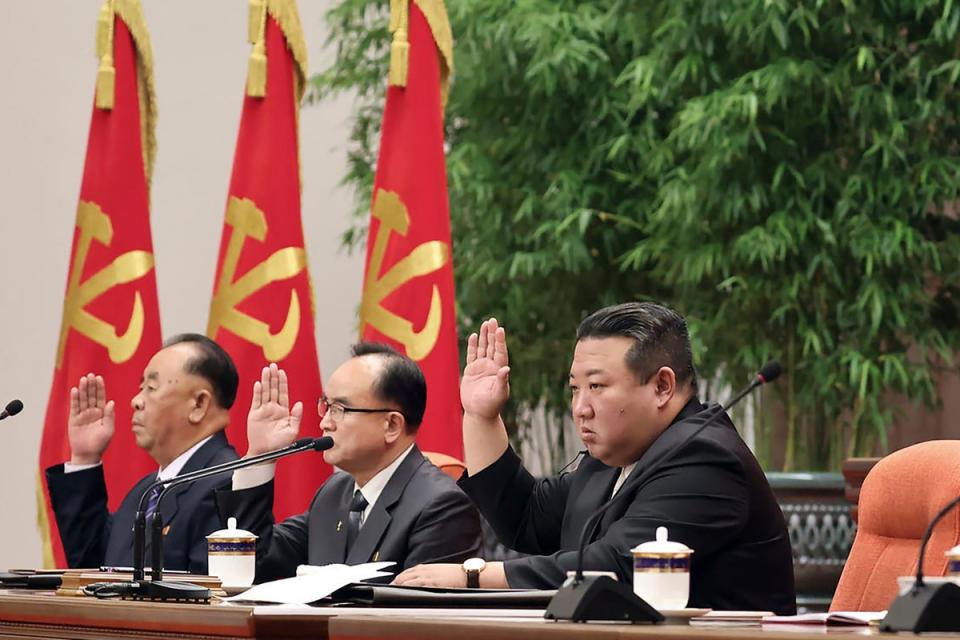North Korea launches intercontinental ballistic missile towards Japan after threatening US

North Korea has launched a suspected intercontinental ballistic missile (ICBM) off its east coast, Japanese officials said.
The missile was launched at 9.59am local time from the capital Pyongyang and fell into the Sea of Japan at 11.15am local time after almost an hour-long flight, Japan’s Coast Guard said citing the defence ministry.
That would make it the longest-ever flight of a North Korean ballistic missile test, at 74 minutes, TV Asahi said citing a Japanese defence ministry official.
The launch took place as US top military general Mark Milley was holding a rare trilateral meeting with his South Korean and Japanese counterparts in Hawaii.
Colonel Dave Butler, a spokesman for Mr Milley, said the launch occurred at a time they were concluding the Hawaii meeting.
North Korea test-fired a missile after Pyongyang threatened to shoot down US military reconnaissance planes and warned of “shocking” consequences if they continued to fly near its territory.
Kim Yo-jong, sister of North Korean leader Kim Jong-un and herself a senior North Korean official, accused the US spy planes of violating its air space at least eight times on Monday, according to a statement on Tuesday from state news agency KCNA.
“In case of repeated illegal intrusion, the US forces will experience a very critical flight,” Ms Kim warned in the statement.
The launch prompted the South Korean and Japanese militaries to maintain readiness and bolstered surveillance posture.
Japan’s chief cabinet secretary Hirokazu Matsuno said that the missile flew at an altitude of 6,000kms and landed about 250kms west off Okushiri Island in the north of Japan.
He condemned the launch as “absolutely unacceptable” and called out North Korea for destabilising the peace and security of the region.
The latest launch also comes as world leaders are meeting for major diplomatic and security gatherings this week, including the ongoing North Atlantic Treaty Organization (Nato) summit in Lithuania and the ASEAN Regional Forum in Indonesia.
Japnese prime minister Funio Kishida who is in Lithuania for the Nato summit ordered the military to gather information and stay alert for preparation of any untoward events, according to the prime minister’s office.
South Korean president Yoon Suk-yeol who is also in Baltic region country of Europe for the summit is expected to discuss North Korea’s growing military threats with the leaders to seek security cooperation.
Mr Kishida and Mr Yeol are also expected to meet on the sidelines of the Nato gathering while a summit was also planned with South Korea, Australia and New Zealand.
North Korea’s long-range ballistic missile programmes target the mainland US as the missiles are capable of travelling with a range greater than 5,500 and delivering nuclear warheads. Since 2017, the country has conducted a slew of ICBM tests as part of its efforts to flex its military muscles with weapons capable of striking major US.
The 12th missile test this year came after Pyongyang’s last long-range missile test on 13 April, when it fired the most advance Hwasong-18 solid-fuel ICBM. The missile launch briefly prompted Japan to issue evacuation in Hokkaido.
Leif-Eric Easley, a professor at Ewha University in Seoul, said the timing of test by the North Korean leadership could be an attempt to disrupt coordination against it in high-level meetings.
“Kim Yo-jong’s bellicose statement against US surveillance aircraft is part of a North Korean pattern of inflating external threats to rally domestic support and justify weapons tests,” Mr Easley said.
“Pyongyang also times its shows of force to disrupt what it perceives as diplomatic coordination against it, in this case, South Korea and Japan’s leaders meeting during the Nato summit.”

 Yahoo Finance
Yahoo Finance 